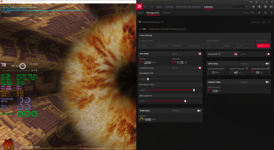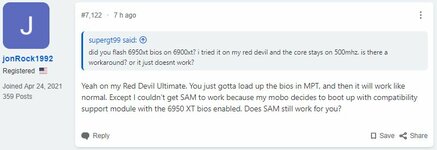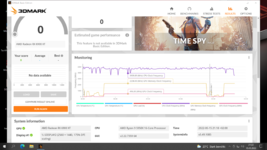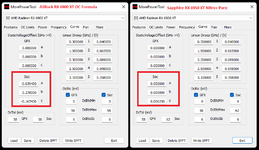Butanding1987
Profi
- Mitglied seit
- 04.08.2021
- Beiträge
- 153
- Ort
- Philippines
- Details zu meinem Desktop
- Prozessor
- Delidded 7950X3D / 5950x
- Mainboard
- Asrock X670E Taichi / MSI X570s Unify-X Max
- Kühler
- Custom loop — 2x360mm RAD, Bykski GPU block, Mycro, 3xD5/3x360mm RAD, GPU Eisblock, TechN AM4, 1xD5
- Speicher
- Patriot 8000@6400 CL28 / G.Skill 3800 CL14
- Grafikprozessor
- Sapphire 7900 XTX Nitro+ / Sapphire RX 6800 XTk Nitro+
- Display
- 3440x1440p / 3440x1440p
- SSD
- 2TB Kingston Fury Renegade / 1TB Kingston KC3000
- Gehäuse
- Asus GT501 / Asus GT 502
- Netzteil
- Corsair HX1500i / Seasonic Prime Platinum 1300w
- Betriebssystem
- Windows 11
I didn't know increasing voltage to boost clocks was a novelty, because that's what I've been doing for the past year. But you can only do so much as far as the 6800 XT is concerned (and I reckon any 6000 series cards). Using the EVC2 to increase voltage, I managed to boost my clocks to max 2,837MHz. There's a point where increasing volts does not yield any more clocks.
But if you've seen my Time Spy and Fire Strike results, I have managed to trick the card into boosting to more than 2.9GHz (watercooled) using another method that if I divulge means saying goodbye to my top spot among the world's 6800 XTs. I think my discovery makes LN2 with the 6800 XT worthwhile because you can then run it at ~3GHz.
I think my discovery makes LN2 with the 6800 XT worthwhile because you can then run it at ~3GHz.
But if you've seen my Time Spy and Fire Strike results, I have managed to trick the card into boosting to more than 2.9GHz (watercooled) using another method that if I divulge means saying goodbye to my top spot among the world's 6800 XTs.
 I think my discovery makes LN2 with the 6800 XT worthwhile because you can then run it at ~3GHz.
I think my discovery makes LN2 with the 6800 XT worthwhile because you can then run it at ~3GHz.




 Sonst alles stock, nur MPT GPU Powerlimit offen.
Sonst alles stock, nur MPT GPU Powerlimit offen.





















 bis jetzt.Gut Ding braucht Weile
bis jetzt.Gut Ding braucht Weile























